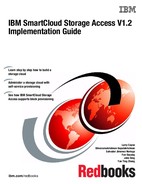

Planning, installation, and basic configuration of IBM SmartCloud Storage Access
This chapter describes how to install IBM SmartCloud Storage Access on supported platforms, how to set up IBM SmartCloud Storage Access, and how to perform basic configuration to manage the storage cloud environment.
This chapter covers the following key topics:
•IBM SmartCloud Storage Access planning considerations, including hardware and software requirements
•IBM SmartCloud Storage Access installation process, including kernel-based virtual machine (KVM) and Open Virtualization Format (OVF) formats
•Basic configuration flow for IBM SmartCloud Storage Access
•Registering the required servers for IBM SmartCloud Storage Access
7.1 Planning
Planning for IBM SmartCloud Storage Access includes the hardware and software requirements for IBM SmartCloud Storage Access installation and other components.
7.1.1 Hardware planning
This topic describes the suggested hardware for IBM SmartCloud Storage Access-supported platforms. Treat the information provided in this topic as general guidelines. The actual requirements can vary from installation to installation. Specific sizing ought to be done to meet your installation requirements.
During the writing of this publication, IBM SmartCloud Storage Access server is supported in the following environments:
•VMware ESX/ESXi server
•Red Hat Enterprise Linux (RHEL) server
Table 7-1 describes both the minimum hardware requirements and the suggested minimum production hardware requirements for the IBM SmartCloud Storage Access server components. The minimum requirements listed indicate the absolute minimum hardware levels needed when running with 5-10 concurrent users.
The suggested minimum production hardware requirements support a small cloud. As with any software solution, the hardware must be properly sized for a specific installation scenario.
Table 7-1 Suggested minimum IBM SmartCloud Storage Access hardware requirements
|
Component
|
Minimum hardware requirements
|
Suggested minimum production hardware requirements
|
|
SmartCloud Storage Access server
|
1 processor (4 cores)
100 GB free disk space
16 GB physical memory
|
4 processors
100 GB free disk space
16 GB physical memory
|
|
These requirements are for the SmartCloud Storage Access server only. The requirements might change if other servers, such as the Tivoli Storage Productivity Center server, are installed on the same system.
|
||
In our testing environment, IBM SmartCloud Storage Access was installed on a virtual machine (VM) with 4 processors, 16 GB memory, and 100 GB disk space.
7.1.2 Software planning
This topic describes the related software versions supported by IBM SmartCloud Storage Access. Software versions used in the IBM SmartCloud Storage Access solution, and their version requirements, are listed in Table 7-2 on page 143.
Table 7-2 Version requirements of the software used in the IBM SmartCloud Storage Access solution
|
Software
|
Version required
|
Notes
|
|
VMware ESX/ESXi Server
|
•V4.x (64 bits)
•V5.x (64 bits)
|
With the latest fix pack
|
|
Red Hat Enterprise Linux Server
|
V6.3
|
With the latest fix pack
|
|
Lightweight Directory Access Protocol (LDAP) version 3
|
IBM Tivoli Directory Server V6.1
|
With the latest fix pack
|
|
Microsoft Active Directory (AD)
|
•Windows 2008 R2
•Windows 2012
|
With the latest fix pack
|
|
Mozilla Firefox
|
V4 and later
|
•With the latest fix pack
•Resolution of 1024 x 768 or greater
|
|
Google Chrome
|
V23 and later
|
With the latest fix pack
|
|
Microsoft Internet Explorer
|
V9.0
|
With the latest fix pack
|
|
Others
|
Simple Mail Transfer Protocol (SMTP)
|
No special requirement
|
|
Domain Name System (DNS)
|
||
|
Network Time Protocol (NTP)
|
|
Important: Use of browser clients other than the supported clients might be unsuccessful.
|
IBM SmartCloud Storage Access requires the following specific versions of IBM Tivoli Storage Productivity Center in combination with specific firmware versions in storage devices. These versions are listed in Table 7-3.
Table 7-3 Version support for Tivoli Storage Productivity Center and storage devices
|
Tivoli Storage Productivity Center server version
|
IBM Scale Out Network Attached Storage version
|
IBM Storwize V7000 Unified version
|
IBM System Storage SAN Volume Controller version
|
IBM Storwize V7000 version
|
IBM XIV version
|
|
V5.1.1 with latest fix pack
|
Up to V1.3.2
|
Up to V1.4.0
|
N / A
|
N / A
|
N / A
|
|
V5.2.0 with latest fix pack
|
Up to V1.4.2
|
Up to V1.4.2
|
V7.1.0
|
V7.1.0
|
V11.2
|
7.1.3 Scalability and limitation considerations
If the environment meets the minimum hardware requirements, you can add multiple storage devices in the cloud without a capacity limit. However, each IBM Scale Out Network Attached Storage system has limitations on the maximum number of shares and exports, and IBM Storwize V7000 Unified systems have limitations on the maximum number of file modules. Also, IBM System Storage SAN Volume Controller (SAN Volume Controller), IBM Storwize V7000, and IBM XIV systems have limitations on the maximum number of block modules.
For more information regarding IBM Scale Out Network Attached Storage limitations, see the following website:
For more information regarding Storwize V7000 Unified limitations, see the following website:
For more information regarding SAN Volume Controller limitations, see the following website:
For more information regarding Storwize V7000 limitations, see the following website:
For more information regarding XIV limitations, see the following website:
IBM SmartCloud Storage Access can support 50 concurrent users in the suggested hardware environments. The number of concurrent users can be increased by increasing the capacity in the hardware environment.
Currently, IBM SmartCloud Storage Access does not support direct import of the existing file shares (on IBM Scale Out Network Attached Storage or Storwize V7000 Unified) and block volumes (on XIV, Storwize V7000, or SAN Volume Controller) into the storage cloud environment. If you have this solution requirement, contact IBM. IBM provides the service to help clients migrate their existing file shares or block volumes to the IBM SmartCloud Storage Access storage cloud environment.
7.1.4 IBM SmartCloud Storage Access terminology
Some IBM SmartCloud Storage Access terms commonly used in this publication are described in Table 7-4.
Table 7-4 Some terms used in IBM SmartCloud Storage Access environment
|
Term
|
Description
|
|
Storage Manager
|
Management server for the back-end storage subsystems. In the IBM SmartCloud Storage Access environment, it is actually the Tivoli Storage Productivity Center server.
|
|
Storage profile
|
User-defined groups of service levels make up storage profiles. Each storage profile can be considered from a storage tiering perspective (such as performance, availability, and so on), and it can contain multiple service levels (such as gold, silver, and so on).
|
|
Service Level
|
A cloud administrator can define different service levels for tiered storage services to users. Service levels are mapped to service classes in Tivoli Storage Productivity Center. Currently, each service level corresponds to one service class.
|
|
Capacity pool
|
Storage resource group provided by storage server. Each capacity pool shown in IBM SmartCloud Storage Access is a Cloud capacity pool defined in Tivoli Storage Productivity Center.
|
|
Resource pool
|
After a capacity pool is registered, it becomes an IBM SmartCloud Storage Access cloud resource pool that can be used in a storage environment to allocate resources.
|
|
Storage environment
|
Working environment for a group of users with a group of shared storage resources. Cloud administrators can associate the storage environment with multiple service levels. Users in a specific storage environment are able to request for storage capacity.
|
|
Network drive
|
The space allocated from a storage environment. Users can access a network drive (if they have the privilege). This space is then used for various business purposes (such as uploading or downloading files in the environment).
|
Figure 7-1 presents relationships among the objects defined in IBM SmartCloud Storage Access and Tivoli Storage Productivity Center.

Figure 7-1 Relationships between IBM SmartCloud Storage Access and Tivoli Storage Productivity Center objects
For each Cloud capacity pool defined in Tivoli Storage Productivity Center, there is a resource pool in IBM SmartCloud Storage Access registered on it. Also, for each service class defined in Cloud Analytics, a service level on IBM SmartCloud Storage Access can be mapped to it. A storage profile can contain multiple service levels.
In addition, a storage environment will be defined with a total capacity and some service levels. Users can apply for network drives of a specific service level from the storage environment. If the request is approved by the cloud administrator, a network drive with the requested level will be created for that user, and the space for it will be assigned from a resource pool.
7.2 IBM SmartCloud Storage Access installation
IBM SmartCloud Storage Access is an appliance, and it must be installed on a separate VMware VM or KVM.
|
Tip: IBM SmartCloud Storage Access cannot be installed on an existing VM.
|
Installing IBM SmartCloud Storage Access on VMware ESX
IBM SmartCloud Storage Access is provided as an Open Virtual Appliance (.ova) format package, so it can be deployed directly from an ESX vSphere client to VMware ESX.
Follow these steps to install a new IBM SmartCloud Storage Access appliance:
1. Open the vSphere and log on to an ESX host, then select File → Deploy OVF Template. The Deploy OVF Template window displays, as shown in Figure 7-2.

Figure 7-2 Deploy OVF template in vSphere
2. Browse for the file location of the IBM SmartCloud Storage Access OVF package, as shown in Figure 7-3. After selecting it, click Next to continue.
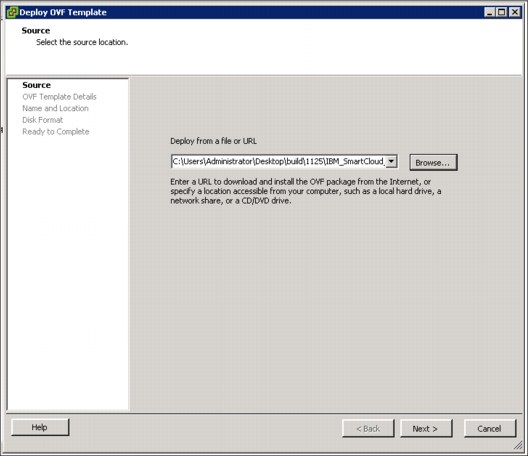
Figure 7-3 Select location of IBM SmartCloud Storage Access OVF package

Figure 7-4 Review the OVF template information
4. Name the IBM SmartCloud Storage Access VM, as shown in Figure 7-5. Click Next after you complete the input.
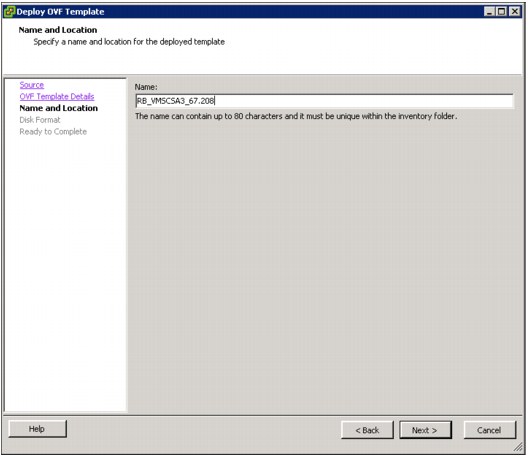
Figure 7-5 Enter the name of IBM SmartCloud Storage Access virtual machine
5. Determine the disk type of the VM. It can be set as Thick Provision (100 GB disk space) or Thin Provision (2.4 GB actual disk space), as shown in Figure 7-6. Accept the default unless the ESX server disk space is insufficient. Click Next to continue.

Figure 7-6 Select the disk type of IBM SmartCloud Storage Access VM
6. Review the virtual machine settings and click Finish to start the deployment, as shown in Figure 7-7.

Figure 7-7 Review IBM SmartCloud Storage Access VM settings
7. For more information regarding setting up IBM SmartCloud Storage Access, see “Setting up IBM SmartCloud Storage Access” on page 153.
Installing IBM SmartCloud Storage Access on an RHEL 6 Server
IBM SmartCloud Storage Access is provided as a KVM image so that it can be installed on the RHEL 6 Server KVM hypervisor.
Follow these steps to install a new IBM SmartCloud Storage Access appliance:
1. Log in to the RHEL 6 Server as root.
2. Decompress the installation file. Enter the following command:
tar -zxvf SmartCloud_Storage_Access_1.2.0_KVM.tar.gz
3. Navigate to the installation script. Enter the following command to install IBM SmartCloud Storage Access:
./install.sh
The IBM SmartCloud Storage Access image is deployed as part of the installation process.
4. Change the VM name and select the bridge that you want to use, as shown in Figure 7-8.
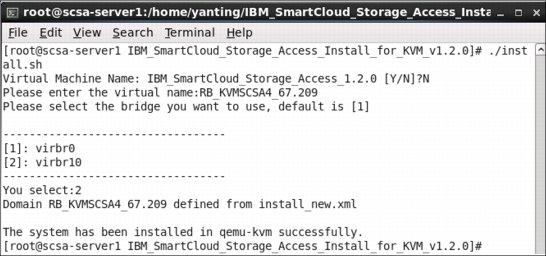
Figure 7-8 Select a bridge in the terminal
5. Select Applications → System Tools → Virtual Machine Manager on the RHEL server. You can see the VM installed, as shown in Figure 7-9.

Figure 7-9 Virtual Machine Manager on RHEL server
6. Right-click the IBM SmartCloud Storage Access VM and select Run, as shown in Figure 7-10. The IBM SmartCloud Storage Access virtual machine status changes to Running.

Figure 7-10 Run the IBM SmartCloud Storage Access virtual machine
7. Right-click the IBM SmartCloud Storage Access virtual machine and click Open. You can start the IBM SmartCloud Storage Access setup process. For more information regarding setting up IBM SmartCloud Storage Access, see “Setting up IBM SmartCloud Storage Access” on page 153.
Setting up IBM SmartCloud Storage Access
Follow these steps to set up IBM SmartCloud Storage Access:
1. When the IBM SmartCloud Storage Access VM is deployed, start it and switch to the console. The IP address must be set before accessing IBM SmartCloud Storage Access. Perform the following steps for the initial configuration of IBM SmartCloud Storage Access:
a. Log in with the user name cbadmin and default password cbadmin.
b. Select the language in which to display the license agreement.
c. Enter 1 at the prompt and enter 1 to accept the license agreement.
d. Proceed with the configuration wizard (see Figure 7-11 on page 154).
e. Enter a new password and retype it to confirm (see Figure 7-12 on page 154). Record the password for later use.
f. Select a network interface to configure. Press Enter to configure the default interface (eth0).
g. Choose whether to use Dynamic Host Configuration Protocol (DHCP). The default answer is no.
h. Enter the IP address for the IBM SmartCloud Storage Access management Ethernet port. The IP address should be provided in Classless Inter-Domain Routing (CIDR) format (for example, 9.111.67.208/24), and press Enter to confirm.
i. Enter the IP address for the default gateway (for example, 9.111.67.1), and press Enter to confirm.
After setting the network parameters, IBM SmartCloud Storage Access is now ready to use.
Figure 7-11 shows language selection in the configuration wizard.

Figure 7-11 Language and license window
Figure 7-12 shows entering and confirming a new password.
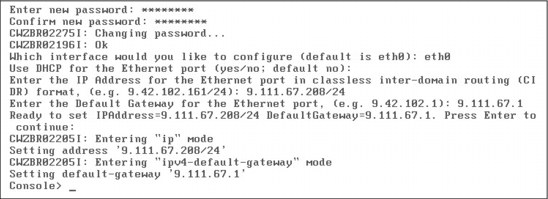
Figure 7-12 IBM SmartCloud Storage Access initial configuration for network
2. After the initial configuration, there might be a requirement to change the network settings. To achieve it, enter the following commands from the vSphere Client console.
Run the list ethernet-interface command to list the available Ethernet interfaces. The results of the command are shown in Example 7-1.
Example 7-1 List of the Ethernet interfaces
Console> show ethernet-interface eth0
ethernet-interface eth0: [Up]
name "eth0"
AdminState "Enabled"
use-arp "true"
aggregate-candidate "false"
mtu "1500"
ip
use-dhcp "false"
address "9.111.67.205/24"
ipv4-default-gateway
gateway "9.111.67.1"
metric "0"
end ipv4-default-gateway
use-slaac "false"
dad-transmits "1"
dad-retransmit-timer "1000"
end ip
mode "Auto"
Console> edit ethernet-interface eth0
Console ethernet-interface:eth0> AdminState enabled
Console ethernet-interface:eth0> ip
CWZBR02205I: Entering "ip" mode
Console ethernet-interface:eth0 ip> use-dhcp false
Console ethernet-interface:eth0 ip> reset address
Console ethernet-interface:eth0 ip> address 9.111.67.209/24
Console ethernet-interface:eth0 ip> ipv4-default-gateway
CWZBR02205I: Entering "ipv4-default-gateway" mode
Console ethernet-interface:eth0 ip ipv4-default-gateway> reset gateway
Console ethernet-interface:eth0 ip ipv4-default-gateway> gateway 9.111.67.1
Console ethernet-interface:eth0 ip ipv4-default-gateway> exit
Console ethernet-interface:eth0 ip> exit
Console ethernet-interface:eth0> exit
3. To show the services status of IBM SmartCloud Storage Access, enter the scstatus command, as shown in Example 7-2.
Normally, all of the services (derby, kernelservices, storehouse, and storagecloud) will be running.
Example 7-2 IBM SmartCloud Storage Access running status
Console> scstatus
derby start/running, process 2863
kernelservices start/running, process 4692
storehouse start/running, process 4689
storagecloud start/running 4875
Console>
If any service is not running, use the screstart command at the console to restart all of the services. Similarly, you can use scstop to stop IBM SmartCloud Storage Access services, and scstart to start IBM SmartCloud Storage Access services.
4. After IBM SmartCloud Storage Access installation completes successfully, it can be accessed with telnet, Secure Shell (SSH), and the web. Most functions are available in the IBM SmartCloud Storage Access web graphical user interface (GUI), and the GUI provides an easy way to monitor and manage the storage cloud environment. In our examples, we use the web GUI most of the time to perform various activities under IBM SmartCloud Storage Access.
To access the IBM SmartCloud Storage Access web interface GUI, open Firefox and redirect to https://<SCSA_IP>:8443. Log in with cbadmin as the User Name and Password, as shown in Figure 7-13.
Figure 7-13 IBM SmartCloud Storage Access logon page
5. When the home page displays, IBM SmartCloud Storage Access is ready to use. See Figure 7-14 on page 157.

Figure 7-14 IBM SmartCloud Storage Access home page
Setting up IBM SmartCloud Storage Access for federated authentication
If Federated Authentication (FA) is planned to be enabled for the storage cloud environment, the following configuration must be done in the IBM SmartCloud Storage Access console:
1. Set the DNS server and set the host name of IBM SmartCloud Storage Access server.
|
Important: The host name configured for the IBM SmartCloud Storage Access must be included in the DNS Forward Lookup Zones and Reverse Lookup Zones. See DNS Server Configuration in 4.2.3, “AD configuration considerations for IBM SmartCloud Storage Access” on page 61 for more details.
|
2. Set the NTP server or synchronize the date and time between IBM SmartCloud Storage Access server and AD server manually.
3. Restart IBM SmartCloud Storage Access.
Figure 7-15 shows the configuration for this publication environment on the IBM SmartCloud Storage Access console to enable FA.

Figure 7-15 FA setting in the IBM SmartCloud Storage Access console
7.3 IBM SmartCloud Storage Access basic configuration flow
Numerous functions are provided by the IBM SmartCloud Storage Access menus. For simplicity, those functions are organized in sequences to present a general configuration flow, as shown in Figure 7-16.

Figure 7-16 IBM SmartCloud Storage Access function dependencies and flows
In Figure 7-16 on page 158, each column represents a menu item in IBM SmartCloud Storage Access (Instances, Storage, Configuration, and Administration), and is distinguished with a different color.
The IBM SmartCloud Storage Access function usage period can also be divided into four stages:
1. Preparation
Before any other functions can be performed, Storage Managers and Security must be set. IBM SmartCloud Storage Access cannot configure without a Tivoli Storage Productivity Center server. Similarly, IBM SmartCloud Storage Access cannot add users or user groups if LDAP/AD server is not defined in Security.
|
Tip: After logging in to IBM SmartCloud Storage Access for the first time, add the Tivoli Storage Productivity Center server and LDAP/AD server information immediately. It is necessary to verify that the Tivoli Storage Productivity Center and LDAP/AD settings are correct, and to enable other functions as well.
|
2. Configuration environment settings
After the Tivoli Storage Productivity Center server and LDAP/AD server are registered in IBM SmartCloud Storage Access, a cloud administrator can then set up the storage cloud environment. The administrator can create storage profiles (to define tiers), resource pools (to provide capacity), and storage environments. Users and user groups are also imported into IBM SmartCloud Storage Access at this stage, so that those accounts can apply for storage resources. The cloud administrator should also set the system global policies.
3. Operation
When the storage environments, users, and user groups are defined, users can apply for network drives to acquire storage resources. Those user applications are sent to the cloud administrators as requests. The requests can be approved or rejected. If approved, a network drive is then created and assigned to the corresponding user.
4. Monitoring and troubleshooting
When IBM SmartCloud Storage Access is in production and going through numerous day-to-day operations, there will certainly be the requirements of different kinds of cloud usage reports. At the same time, in a production environment, logs are required in the event of any failure. Cloud administrators can use the corresponding functions (Audit Log, Task Queue, Reports, and Troubleshooting) to achieve this goal.
The following list describes some dependencies with the functions:
•In the Storage menu, the storage managers, storage profiles, resource pools, and storage environments must be defined one by one.
•In the Administration menu, LDAP or AD server must be input in the Security panel before any users or user groups can be defined.
•The network drives cannot be created before the storage environments and the users are defined.
To summarize, the basic configuration flow of IBM SmartCloud Storage Access is as follows:
1. Register the Tivoli Storage Productivity Center server and the LDAP/AD server.
2. Configure storage until the storage environments are created.
3. Add users and user groups.
4. User applies for network drives and cloud administrator processes the requests.
7.4 Preparing to use IBM SmartCloud Storage Access
As described in 7.3, “IBM SmartCloud Storage Access basic configuration flow” on page 158, to perform any activity on IBM SmartCloud Storage Access, the Tivoli Storage Productivity Center server and the LDAP/AD server must be registered first. There are some other required services to be set for IBM SmartCloud Storage Access as well. This section explains the procedure for registering these important components (Tivoli Storage Productivity Center, LDAP/AD, SMTP, DNS, and NTP).
|
Remember: At this time, Tivoli Storage Productivity Center server is the only storage manager supported by IBM SmartCloud Storage Access V1.2, and only one instance of Tivoli Storage Productivity Center is supported.
|
7.4.1 Registering Tivoli Storage Productivity Center server
Follow these steps to register Tivoli Storage Productivity Center server so that the storage resources can be used by IBM SmartCloud Storage Access:
1. Go to Storage → Storage Managers, and click the green plus sign (+) on the upper-left corner to add a new Tivoli Storage Productivity Center server, as shown in Figure 7-17.

Figure 7-17 Add storage managers in IBM SmartCloud Storage Access
2. In the New Storage Manager dialog (Figure 7-18 on page 161), input all necessary information to connect the Tivoli Storage Productivity Center server:
Name The Tivoli Storage Productivity Center server name shown in IBM SmartCloud Storage Access.
Description An explanation sentence to describe the Tivoli Storage Productivity Center server.
Source Type The type of server. Currently, only Tivoli Storage Productivity Center is available at present.
Host name/IP The host name or IP address of the Tivoli Storage Productivity Center server.
Port The port of the Tivoli Storage Productivity Center server.
|
Note: The Host name/IP - Port combination must be unique to identify the Tivoli Storage Productivity Center server.
|
User name The user name to use to access the Tivoli Storage Productivity Center server.
Password The password of the user to use to access the Tivoli Storage Productivity Center server.

Figure 7-18 Enter the Tivoli Storage Productivity Center server information
After the information is completed, click Test Connection to verify the communication between IBM SmartCloud Storage Access and Tivoli Storage Productivity Center, or click Save to add the Tivoli Storage Productivity Center server directly.
3. After the Tivoli Storage Productivity Center server is added, you can verify whether the storage resource information displayed on the IBM SmartCloud Storage Access page is correct.
|
Important: The capacity pools should correspond to the Cloud capacity pools defined on Tivoli Storage Productivity Center (they have the same name), and the service levels (that is, service classes defined on Tivoli Storage Productivity Center) should classify the storage capacity as you expected. See Figure 7-19.
|

Figure 7-19 Storage information in IBM SmartCloud Storage Access after adding Tivoli Storage Productivity Center server
7.4.2 Registering the LDAP/AD server
The authentication server (LDAP or AD) is a key component of storage cloud environment. In the IBM SmartCloud Storage Access GUI, perform the following steps to register an authentication server so that new user accounts or user groups can be imported.
Configuring LDAP authentication
Follow these steps to register the LDAP server in IBM SmartCloud Storage Access:
1. Go to Administration → Security and click Edit in the External Authentication section, as shown in Figure 7-20.
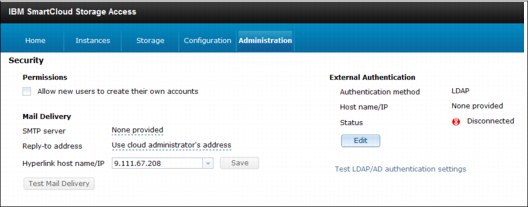
Figure 7-20 External Authentication in IBM SmartCloud Storage Access security page

Figure 7-21 Configure Authentication window
3. Complete the required information in LDAP window. See Figure 7-22.

Figure 7-22 LDAP window
Table 7-5 contains the sample for LDAP settings.
Table 7-5 Field explanation for LDAP settings
|
Field value
|
Input sample
|
Comments
|
|
Java Naming and Directory Interface (JNDI) provider Uniform Resource Locator (URL)
|
ldap://9.111.67.204:389
|
JNDI provider, with or without the port number. If the port number is not specified, the default port number for a non-Secure Sockets Layer (SSL) LDAP is 389. For an SSL LDAP, if the port number is not specified, the default port number is 636.
|
|
JNDI base distinguished name (DN), for users
|
cn=users,dc=scsa2,dc=ibm,dc=com
|
|
|
JNDI base DN (groups)
|
cn=groups,dc=scsa2,dc=ibm,dc=com
|
|
|
Search filter (users)
|
(&(uid={0})(objectclass=posixGroup))
|
A user ID is embedded in the {0} place holder, and is replaced by the login user ID that you entered in the login window.
|
|
Domain name
|
scsa2.ibm.com
|
If you do not enter a domain name, domain users will need to enter domain and user name rather than only user name when they download the mount script for the network drive and run it.
|
|
Email attribute
|
email
|
|
|
Full name attribute
|
cn
|
|
|
JNDI security authentication
|
cn=root
|
Administrator DN for the authentication server.
|
|
Password
|
******
|
Password of the administrator for the authentication server.
|
4. After inputting all information, click Test Connection to verify the communication between LDAP and IBM SmartCloud Storage Access, or click Save to finish the configuration.
5. Enter an existing user name or user group and click Test query. If the LDAP server can be connected correctly and the user or user group is already created, the test will pass with a result message. Otherwise there will be an error message, see Figure 7-23.

Figure 7-23 Test query page
Configuring AD authentication
Follow these steps to register the AD server in IBM SmartCloud Storage Access:
1. Go to Administration → Security and click Edit in the External Authentication section, as shown in Figure 7-24.

Figure 7-24 External Authentication in IBM SmartCloud Storage Access security page

Figure 7-25 Configure Authentication window
3. Complete the required information in the Active Directory window. See Figure 7-26.

Figure 7-26 Active Directory window
Table 7-6 contains the sample for AD settings.
Table 7-6 Field explanation for AD settings
|
Field value
|
Input sample
|
Comments
|
|
Server
|
9.111.67.200
|
|
|
User ID
|
Administrator ID with domain.
|
|
|
Password
|
********
|
Password of the administrator for the authentication server.
|
|
Default domain
|
scsa.ibm.com
|
|
4. Click the sync icon to find all of the domains, and select the default domain from the list field. When a default domain is set, users in the default domain do not need to include the domain as part of the login. Users that are part of a domain that is not the default domain do need to include the domain as part of the login.
5. After inputting all required information, click Test Connection to verify the communication between AD and IBM SmartCloud Storage Access, or click Save to finish the configuration.
6. Enter an existing user name or user group and click Test query. If the AD server can be connected correctly, and the user or user group is already created, the test will pass with a result message. Otherwise, there will be an error message.
7.4.3 Registering SMTP, DNS, and NTP
Follow these steps to register SMTP, DNS, and NTP:
1. Configuring SMTP
In IBM SmartCloud Storage Access, an SMTP server should be registered, and a reply-to address will be used for password resets and event notifications:
a. Select Administration → Security from the menu, in the left panel of the security page, in the Mail Delivery section (as shown in Figure 7-27 on page 167).
b. Add the IP address or host name of the SMTP server field. If a host name is entered, the host name must be resolved in the defined DNS servers.
c. Add the administrator’s email address in the Reply-to address field. The email address must be using the same domain.
d. Select the Hyperlink host name/IP. In email notifications all portal links are replaced by the value specified in this window.
Figure 7-27 shows email security information for SMTP setup in IBM SmartCloud Storage Access.

Figure 7-27 SMTP registration in IBM SmartCloud Storage Access security page
The cloud administrator can test the email notification function:
e. Click the Test Mail Delivery button.
f. The administrator (who is logged in) must set his email address first by clicking the user name that appears on the upper-right section of IBM SmartCloud Storage Access GUI, and then entering a valid email address. See Figure 7-28.

Figure 7-28 Set email address for the login user
2. Configuring DNS
Follow these steps to configure DNS:
a. Use telnet or SSH to log in IBM SmartCloud Storage Access appliance console.
b. Use the set-dns-servers command to set DNS servers for IBM SmartCloud Storage Access.
Example 7-3 DNS registration in IBM SmartCloud Storage Access console
Console> set-dns-servers 9.111.67.200 9.111.67.200
CWZBR02196I: Ok
Console> get-dns-servers
CWZBR02482I: Domain (DNS) servers:
9.111.67.200
9.111.67.200
Console>
You can specify multiple DNS servers with the set-dns-servers command. If that command is run without any IP address specified, the existing DNS list will be emptied.
3. Configure NTP
Perform the following steps to configure NTP:
a. Use telnet or SSH to log in to the IBM SmartCloud Storage Access appliance console.
b. Use the set-ntp-servers command (Example 7-4) to set NTP servers for IBM SmartCloud Storage Access.
c. Use the get-ntp-servers command to list the NTP servers defined.
Example 7-4 NTP registration in IBM SmartCloud Storage Access console
Console> set-ntp-servers scsa.ibm.com 9.111.67.200
CWZBR02196I: Ok
Console> get-ntp-servers
CWZBR02484I: NTP servers: scsa.ibm.com
9.111.67.200
Console>
You can specify multiple NTP servers in the set-ntp-servers command. If this command is run without any server specified, the existing NTP server list will be cleared.
7.4.4 Next step
After Tivoli Storage Productivity Center server, the LDAP/AD server, and all other required services are registered in IBM SmartCloud Storage Access correctly, the preparation job is done and you are ready to use IBM SmartCloud Storage Access now.
..................Content has been hidden....................
You can't read the all page of ebook, please click here login for view all page.
